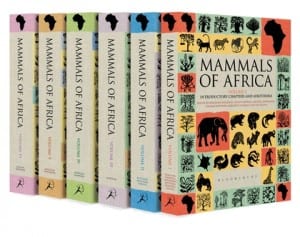Introducing Book Worm… Mammals of Africa: A Review
By Jack Ashby, on 7 March 2013

Book Worm – that’s Grant and a lugworm
We’ve tried a few things with our blog here, but so far book reviews haven’t been much of a feature. That may be about to change with our new predictably punned “Book Worm” feature, and to begin with I’m going for one that really is a bit of an event in zoological publishing – Mammals of Africa, published this month by Bloomsbury, and edited by the legendary Jonathan Kingdon (who also beautifully illustrates the series), David and Merridith Happold, Thomas Butyinksi, Michael Hoffman and Jan Kalina.
My very favourite book to leaf through, because of my own zoological leanings, is Mammals of Australia (Van Dyck and Strahan, 2008). There is something deeply satisfying in completeness, and this book gives detailed and comprehensive information about every single known species of mammal in Australia. Australia is very big, and so is that book. It weighs more than 6kg. Now imagine putting together such a project for Africa, which dwarves Australia in size and variety of biotic zones. It’s a continent more rich in species of rodent than Australia is in species of mammals (and that is to say a lot).
Mammals of Africa, therefore, is comprised of six 6kg volumes, each tackling one sixth of the continent’s diversity, extensively covering all 1116 extant known species. This is probably why such an undertaking has never been undertaken before.
 Within each volume, an overall description and evolutionary history of each family is given, and then subfamily (in the larger groups), genus and then the bulk of the information is in the individual species accounts. The taxonomy, defining characteristics, distribution, habitat, abundance, behaviour and conservation status for every species is clearly presented in a consistent way. Obviously the amount of this information known varies between species.
Within each volume, an overall description and evolutionary history of each family is given, and then subfamily (in the larger groups), genus and then the bulk of the information is in the individual species accounts. The taxonomy, defining characteristics, distribution, habitat, abundance, behaviour and conservation status for every species is clearly presented in a consistent way. Obviously the amount of this information known varies between species.
The information given and the way it is written is extremely clear and engaging. Just flicking through it it’s easy to read a couple of lines in a species’ “Adaption” section and find something memorable, which is often not the case with academic tomes like this.
And this is an academic tome. At £550 for the set it would have to be. People with an interest in a given group of animals are often faced with a choice between buying a huge comprehensive desk book or a lightweight field guide. I’m not just talking about people who spend time in the field looking for them – I have loads of African mammal books, but I’ve never been there (one day…). Both can cover every species in a given area. Cost comes into it, but at the end of the day practical use is a major factor.
I remember walking out to one of my field sites in Australia to check the traps. It was a 2km scramble over a rocky hill covered in very spiky grass which injects alkaloids when it pricks you, followed by a long slog through an ankle deep bog, with cane grass towering 1m above us. Plus we were fully laden with trapping gear. At night. Among our more familiar trapees, we caught a very non-descript rodent our field guide couldn’t help with. For obvious reasons we weren’t carrying the huge Mammals of Australia, but there was one back at base camp. We weren’t going to put the critter through the ordeal of the walk back, but we realised that we had a very weak signal on our radios. Contacting colleagues back at base we managed to get the ID done with the remote use of the huge book.
Mammals of Africa definitely isn’t something you could pop in your back-pack for a day on safari, or probably more remote fieldworkers without the benefit of a radio signal, but it will prove an invaluable resource to people who tend to reference their books at their desks. It is thoroughly referenced and genuinely can’t be beaten as a one-stop shop for in-depth but accessible information about Africa’s mammals, possibly even by the internet.
One note of caution is that the species profiles were submitted by the authors to the editors in 2001-2005. Naturally it has taken them a long time to edit and draw together, but some of the information may have progressed since then.
Flicking through Volume V (Carnivores, Pangolins, Equids and Rhinoceroses) – surely the go to volume for any browser (I don’t mean zoologically – of these species I suspect only the black rhino is a browser) – the sheer quantity and quality of information is simply exciting. The leopard alone gets nine dense pages, with beautiful illustrations, including the musculature, skull (at first I was thrilled by this, from a museum point of view, but unfortunately it doesn’t highlight the defining characteristics of each skull, so won’t be that helpful in identification) and various different poses and behaviours. It really is a masterpiece.
 Close
Close

